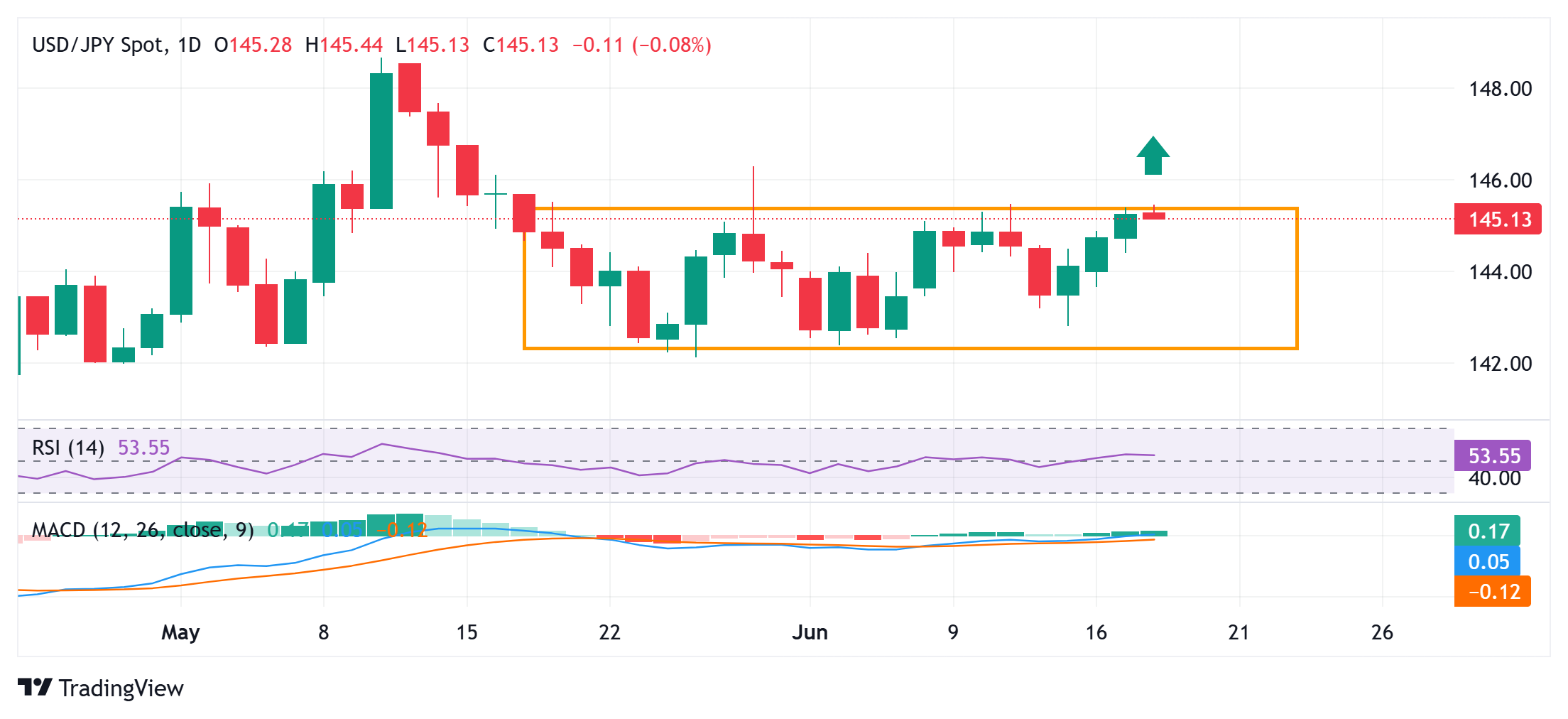Japanese Yen languishes near monthly low against USD on mixed BoJ rate hike cues
- The Japanese Yen retests the monthly swing low against its American counterpart.
- Reduced bets for a BoJ rate hike in 2025 and trade uncertainties weigh on the JPY.
- The lack of follow-through USD buying caps USD/JPY ahead of the FOMC decision.
The Japanese Yen (JPY) remains on the back foot against its American counterpart for the fourth consecutive day and retests the monthly low during the Asian session on Wednesday. The Bank of Japan (BoJ) signaled a cautious approach to unwinding its decade-long monetary stimulus amid economic growth uncertainties. This forced investors to push back their expectations about the likely timing of the next BoJ rate hike to Q1 2026, which, in turn, is seen undermining the JPY.
Meanwhile, US President Donald Trump and Japan's Prime Minister Shigeru Ishiba failed to achieve a breakthrough on tariffs at the G7 summit, fueling concerns about the economic fallout from US tariffs. This further contributes to the JPY's relative underperformance. The US Dollar (USD), on the other hand, struggles to capitalize on the previous day's strong gains ahead of the crucial FOMC decision and keeps a lid on any further appreciating move for the USD/JPY pair.
Japanese Yen struggles to lure buyers amid fading hopes for another BoJ rate hike in 2025
- The Bank of Japan, as was widely expected, left the benchmark rate unchanged at 0.5% on Tuesday amid rising growth risks and said that it will slow the pace of reductions in its government bond purchases from April next year. The BoJ added that Japan’s economic growth was likely to moderate and that accommodative financial conditions are expected to provide support.
- This reinforced market expectations that the central bank might forego another rate hike this year. In fact, a recent Reuters poll indicated that a slight majority of economists expect the next 25-basis-point rate increase in early 2026. This is seen undermining the Japanese Yen amid roadblocks on the trade front ahead of the July 9 deadline for higher reciprocal US tariffs.
- Japan's Prime Minister Shigeru Ishiba, talking to reporters after the G7 summit on Tuesday, said that he and US President Donald Trump agreed to instruct their ministers to further engage in trade talks. Ishiba added that there are still some points on which the two sides are not on the same page, so we have not yet reached an agreement on the trade package.
- Meanwhile, Japan Machinery Orders fell 9.1% in April ––marking a sharp reversal from a 13% surge in March and the weakest reading since April 2020. Moreover, the monthly Reuters Tankan poll showed that Japanese manufacturers grew less confident about business conditions in June and expressed caution about the outlook for the next three months.
- From the US, the US Census Bureau reported on Tuesday that Retail Sales declined by 0.9% in May compared to a contraction of 0.7% expected. Adding to this, US Industrial Production also fell short of consensus estimates and contracted 0.2% in May, pointing to a softening economy and reaffirming bets for an interest rate cut by the Federal Reserve in September.
- The initial market reaction, however, turned out to be short-lived as rising geopolitical tensions in the Middle East drove safe-haven flows toward the US Dollar. Investors now look forward to the outcome of a two-day FOMC policy meeting for more cues about the future rate-cut path, which will drive the USD and provide a fresh impetus to the USD/JPY pair.
USD/JPY bulls now await a move beyond the 145.45 area before positioning for further gains

From a technical perspective, the overnight breakout and a daily close above the 145.00 psychological mark could be seen as a fresh trigger for the USD/JPY bulls. Moreover, oscillators on the daily chart have just started gaining positive traction and suggest that the path of least resistance for spot prices is to the upside. Some follow-through buying beyond the monthly swing high, around the 145.45 area, will affirm the constructive outlook and allow the pair to conquer the 146.00 round figure before aiming to test the 146.25-146.30 region or the May 29 peak.
On the flip side, any corrective pullback below the 145.00 mark might now attract some dip-buyers and find decent support near the 144.50-144.45 region, below which the USD/JPY pair could slide to the 144.00 mark. A convincing break below the latter would expose the next relevant support near the 143.55-143.50 region before spot prices eventually drop to the 143.00 round figure en route to last Friday's swing low, around the 142.80-142.75 region.
Bank of Japan FAQs
The Bank of Japan (BoJ) is the Japanese central bank, which sets monetary policy in the country. Its mandate is to issue banknotes and carry out currency and monetary control to ensure price stability, which means an inflation target of around 2%.
The Bank of Japan embarked in an ultra-loose monetary policy in 2013 in order to stimulate the economy and fuel inflation amid a low-inflationary environment. The bank’s policy is based on Quantitative and Qualitative Easing (QQE), or printing notes to buy assets such as government or corporate bonds to provide liquidity. In 2016, the bank doubled down on its strategy and further loosened policy by first introducing negative interest rates and then directly controlling the yield of its 10-year government bonds. In March 2024, the BoJ lifted interest rates, effectively retreating from the ultra-loose monetary policy stance.
The Bank’s massive stimulus caused the Yen to depreciate against its main currency peers. This process exacerbated in 2022 and 2023 due to an increasing policy divergence between the Bank of Japan and other main central banks, which opted to increase interest rates sharply to fight decades-high levels of inflation. The BoJ’s policy led to a widening differential with other currencies, dragging down the value of the Yen. This trend partly reversed in 2024, when the BoJ decided to abandon its ultra-loose policy stance.
A weaker Yen and the spike in global energy prices led to an increase in Japanese inflation, which exceeded the BoJ’s 2% target. The prospect of rising salaries in the country – a key element fuelling inflation – also contributed to the move.

